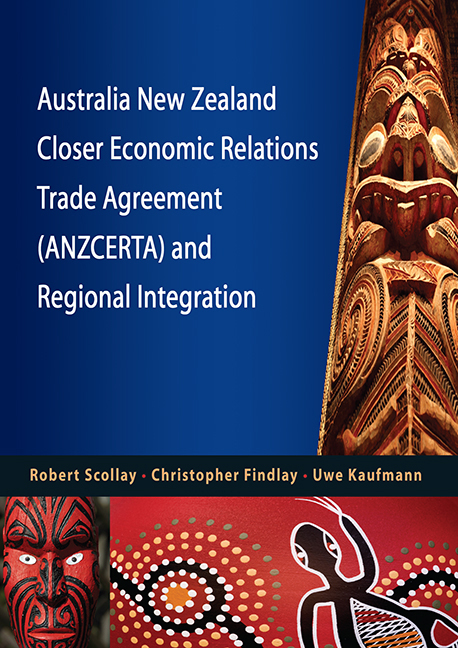Book contents
- Frontmatter
- Contents
- Foreword
- Australia New Zealand Closer Economic Relations Trade Agreement (Anzcerta) and Regional Integration
- Executive Summary
- 1 Introduction
- 2 Background
- 3 Pre-ANZCERTA Trade Arrangements
- 4 Early Years of ANZCERTA
- 5 Consolidation of ANZCERTA
- 6 Deepening Integration
- 7 Pursuit of a Single Economic Market (SEM)
- 8 Further Monetary Integration: A Monetary Union?
- 9 The Economic Effects of ANZCERTA
- 10 Conclusion
- References
- About the Authors
10 - Conclusion
from Australia New Zealand Closer Economic Relations Trade Agreement (Anzcerta) and Regional Integration
Published online by Cambridge University Press: 21 October 2015
- Frontmatter
- Contents
- Foreword
- Australia New Zealand Closer Economic Relations Trade Agreement (Anzcerta) and Regional Integration
- Executive Summary
- 1 Introduction
- 2 Background
- 3 Pre-ANZCERTA Trade Arrangements
- 4 Early Years of ANZCERTA
- 5 Consolidation of ANZCERTA
- 6 Deepening Integration
- 7 Pursuit of a Single Economic Market (SEM)
- 8 Further Monetary Integration: A Monetary Union?
- 9 The Economic Effects of ANZCERTA
- 10 Conclusion
- References
- About the Authors
Summary
This concluding section of the report briefly highlights some of the distinctive features of the process of economic integration between Australia and New Zealand, before going on to consider possible lessons for ASEAN.
In economic integration initiatives there is generally some combination of historical, geographical, political, institutional, and social factors that predisposes the participating countries towards integrating with each other and/or that facilitate the process of integration once it has begun. In the case of Australia and New Zealand these factors have included:
• Shared historical experiences and long-standing culturalties;
• A sense of common geographical and political positioning within the wider surrounding region;
• Similarities in legal systems and regulatory approaches;
• Pre-existing labour mobility between the two countries; and
• Existence of federal/state institutional arrangements in Australia that could be extended relatively easily to New Zealand (covering, for example, government purchasing and mutual recognition).
Despite the factors favouring integration, progress has not been automatic. Significant initial difficulties had to be overcome before a “breakthrough” was achieved that firmly established the commitment to integration on both sides. The early “breakthrough” has been followed by alternating “progressive” and “flat” periods in the integration process.
The following are tentatively put forward as possible lessons for ASEAN from the ANZCERTA experience.
Strong political support at the leadership level has been vitally important in sustaining the momentum of the integration process. This has been especially true in propelling the process across important thresholds, such as the “breakthrough” represented by the 1988 Review, and subsequent periods of transition from “flat” to “progressive” periods in the process.
The pursuit in both countries of wide-ranging economic reform agendas, including strong commitments to unilateral trade liberalization, facilitated political acceptance of individual integration initiatives, which could often be presented as natural extensions of the domestic reform process.
The periodic setting by leaders of objectives for the integration process has been important. Objectives were specified in broad terms rather than as detailed “blueprints” and were accompanied by the establishment of processes of consultation, dialogue, review, and joint study that helped to sustain the momentum of the process in the succeeding years.
- Type
- Chapter
- Information
- Australia New Zealand Closer Economic Relations Trade Agreement (ANZCERTA) and Regional Integration , pp. 99 - 106Publisher: ISEAS–Yusof Ishak InstitutePrint publication year: 2010



